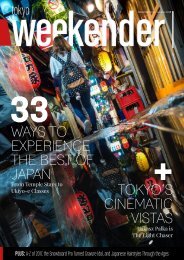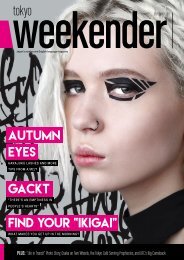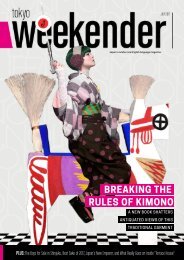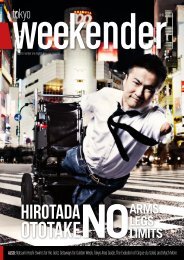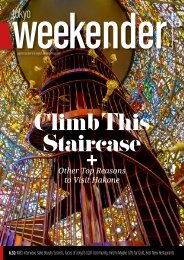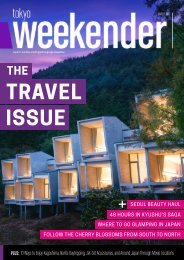Tokyo Weekender - November 2017
Our November issue is out, featuring a jam-packed end-of-year special: 42 Christmas gift shopping ideas and 10 bonenkai spots. Plus: The avant-garde world of butoh dance, Japanese teen prodigies, and a special supplement guide to Akita. Here's where to find a copy around Tokyo: www.tokyoweekender.com/pickup/
Our November issue is out, featuring a jam-packed end-of-year special: 42 Christmas gift shopping ideas and 10 bonenkai spots. Plus: The avant-garde world of butoh dance, Japanese teen prodigies, and a special supplement guide to Akita. Here's where to find a copy around Tokyo: www.tokyoweekender.com/pickup/
You also want an ePaper? Increase the reach of your titles
YUMPU automatically turns print PDFs into web optimized ePapers that Google loves.
EXPLORE KORIYAMA:<br />
The Gateway<br />
to Fukushima<br />
Words by Lisa Wallin. Photographs by Robert Kirsch<br />
If you enjoyed our Tohoku<br />
travel guide, you might<br />
decide to linger longer<br />
and experience more. We<br />
recommend discovering<br />
Koriyama – a city many<br />
have never heard of, yet<br />
is packed with unique<br />
experiences (and also<br />
happens to be a host town<br />
for the Netherlands for the<br />
2020 <strong>Tokyo</strong> Olympics)<br />
Koriyama is almost straight due north<br />
from <strong>Tokyo</strong> and is a gateway to the<br />
rest of Fukushima Prefecture. Once<br />
a village with little arable land,<br />
everything changed in the Meiji era<br />
when Dutch-driven technology and knowhow<br />
created a canal leading from Lake Inawashiro<br />
to the village. The city exploded from a population<br />
of 2,000 to its 330,000-plus residents, and<br />
became a rich cultural and technological hub.<br />
Despite this – and its convenient Shinkansen<br />
station, which is only 77 minutes from <strong>Tokyo</strong> –<br />
the city often gets passed by, both literally and<br />
figuratively. We set out to see what treasures<br />
await here, and were pleasantly surprised.<br />
LIFE, CRAFTS, AND ALL THAT JAZZ<br />
We arrived in Koriyama on a crisp autumn<br />
morning and were instantly whisked off to<br />
Takashiba Deko Yashiki, a collection of five<br />
craft-making houses that have been making<br />
traditional hariko dolls and masks for over 300<br />
years. We had set our sights on painting one of<br />
these papier-mâché figures, but first we were<br />
in for a show – and a lecture on life.<br />
Hiroji Hashimoto, a very spry 72-year-old<br />
and 17th generation doll maker at Hashimoto<br />
Hiroji Mingei, makes 3,000-5,000 dolls and<br />
masks a year at his workshop together<br />
with only one or two staff members. As he<br />
explained the doll construction process, he<br />
got a little deeper. “Everything I make here<br />
is possible because people hundreds of years<br />
before me made these molds and these<br />
dolls,” he said, clearly thankful and amazed<br />
by his forefathers' dedication to the craft.<br />
He continued, on a slight tangent: “However,<br />
it's important to have balance in life. We as<br />
humans dirty our hearts and need to find<br />
a way to clean the soul. I can sit and work<br />
quietly making dolls for hours on end, but if<br />
I only did that, it would be no good. When I<br />
wear one of these masks I become lively ...<br />
It's a kind of release.”<br />
Not quite sure what he meant but<br />
listening eagerly to his advice, we watched<br />
as he put on his mask and transformed into<br />
48 | NOVEMBER <strong>2017</strong> | TOKYO WEEKENDER



